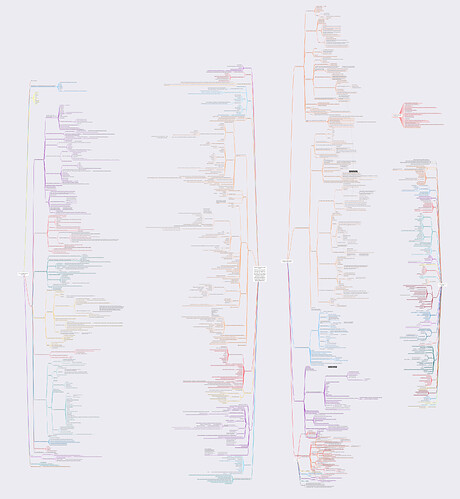Cross-posted from Discord.
This post is a place to discuss the upcoming ‘small business’ system.
The General Idea
Here’s our overall vision. Obviously, it’ll be a Johnny.Decimal system. Probably two areas:
-
10-19 Company Adminwill have all the stuff you expect. That’s what’s on the mind map, below—work in progress. -
20-29 Productwill focus on your product. This is an area that we can’t know much about, and we haven’t talked much about it here yet, but we’ll at least give you guidance. You will get this system by downloading software that builds your system according to your preferences. Do you want the emoji and the header symbols in your file system? Do you want Markdown or plain text JDex files? Do you want tags and wiki-links in them? You’ll choose these options, click a button, and your system will appear.
I have a working proof-of-concept of this already, which builds the Life Admin system from structured data (JSON). It’s a cross-platform Electron app. (Sorry not sorry). It’ll be member-only channels here and on the forum, structured around the system—probably at the ID-header level. So if you want help about 13 > 13.30 Expenses, there’ll be a channel #13.30 Expenses full of people who also have questions or expertise on that topic. This will be mirrored on Discord/Discourse.
Operations manuals
When information appears that we feel should be made permanent, Lucy and I will extract it and make it part of the system. It will live in your operations manuals, which form a key part of the new system. Your JDex tells you where your stuff is; your Ops Manuals tell you how to work. Examples:
-
When you get a new/change your existing bank account, what do you do?
- (You tell the tax office so that they don’t send refunds to your old account… which I learned the hard way yesterday.)
-
How do you ship and send things?
- A simple checklist with the courier’s details, website, your account, etc.
-
Maybe you have quarterly compliance stuff. How do you do that?
-
And so on.
These Ops Manuals will grow over time as we learn from the community. They’ll be locale-specific where necessary—tax is different wherever you live. (And this is why we can’t just write them—we don’t know how tax works in the Netherlands… but @_FJ does!)
Your business community
And finally, we’ll have places like this channel where you can hang out with your colleagues, make connections. Maybe there’ll be a channel where you can present your work and get some sales? Who knows. TBC, but we’re all open to ideas.
I’m in another Discord that promised to be a place for small business people to talk (Daniel Vassallo’s ‘Small Bets’ if you’re interested). It started okay, but the last time I logged in, the channels had all turned into discussions about how to stay healthy by drinking kombucha in the middle of the night and shady drop-shipping techniques. WTF? It’s totally pointless now.
We’ll be carefully moderating these new channels. This is a place to get stuff done. Sure, there’s a lounge for chat, but we want to help you do more work. That’s why you’re here.
It’ll be a subscription
Oh, and I might as well drop it here to gauge the reaction: it’ll be a subscription. I have big plans for this. I want it to turn into the most useful small business resource on the internet. Seriously.
I think I can make your business 1% more efficient. That doesn’t sound like much, but think about the impact to your bottom line. And if we’re going to spend so much time on this, it must be sustainable for us. (The current packs barely are. We scrape by.)
I haven’t decided how much yet and, as always, Decimals who are already here will get a deal.
Of course, your system will never be taken away. What your subscription buys you is community access and the ongoing updates to the Ops Manuals. This puts the onus on us to make it worthwhile.

